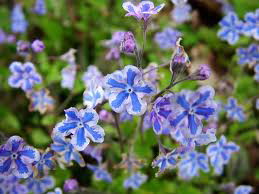OMPHALODES: aka: the creeping forget-me-not
A member of the borage family
It’s a semi rare perennial, it’s easy to grow.

What makes it interesting: A plant is interesting to me if I have never seen it before. We first came across this plant at Heronswood. It continues to be a good performer in the garden and best of all… it is of little or no interest to deer, elk, rabbits or slugs. This is an important consideration in the wet Northwest springs.
How it grows and blooms: It makes a thick ground cover, thick enough to choke out weeds. The leaves are a dry semi sticky consistency. The plants form clumps that can be wide-spreading over time, but grow slowly and are not invasive or aggressive. These will grow to a height of 6-8″.

In early spring, the flowers rise above the leaves in small clusters. The flowers are about a 1/2 inch (1.3 cm) wide. The flowers can range from white to true blue. The green leaves are pointed and have a hairy surface.
These are similar to forget-me-nots, but is not as invasive.
What it needs: It will tolerate a range of areas, from hot afternoon sun to part shade. It seems to be the happiest in part shade, in an area that doesn’t dry out too much.
How to propagate: It has a clump form and features stolons, which are stems that grow horizontally along the soil and connect several plants together. You can gently tear the divisions from the outer borders of the clumps, pot them up or plant them directly into the garden and keep them cool and moist until they take root. This is best done in the early spring of fall. You can put umbrellas over them to protect them from hot sun. ( I often mention the umbrellas because I have a tendency to divide my plants when it’s convenient for me, not when its the ‘best’ time for the plants. Umbrellas are my work-around for dividing in warmer, sunnier weather. )

Problems: They may develop some powdery mildew in consistently wet weather.
How to use it in the landscape:
Use it as a ground cover, under trees or in areas that you want to mitigate summer soil temperatures and where you want some spring color and as a backdrop for later bloomers.
Some favorite varieties:
1.) Blue Eyed Mary: true blue small 5 petal star-shaped flower
2.) Starry eyes: very pale blue, almost white background with darker blue stripes on the small 5 petal star-shaped flower.
There is a white blooming variety that is now on my WISH LIST… verna alba. I will be on the lookout for it in my local nurseries this spring.
